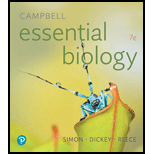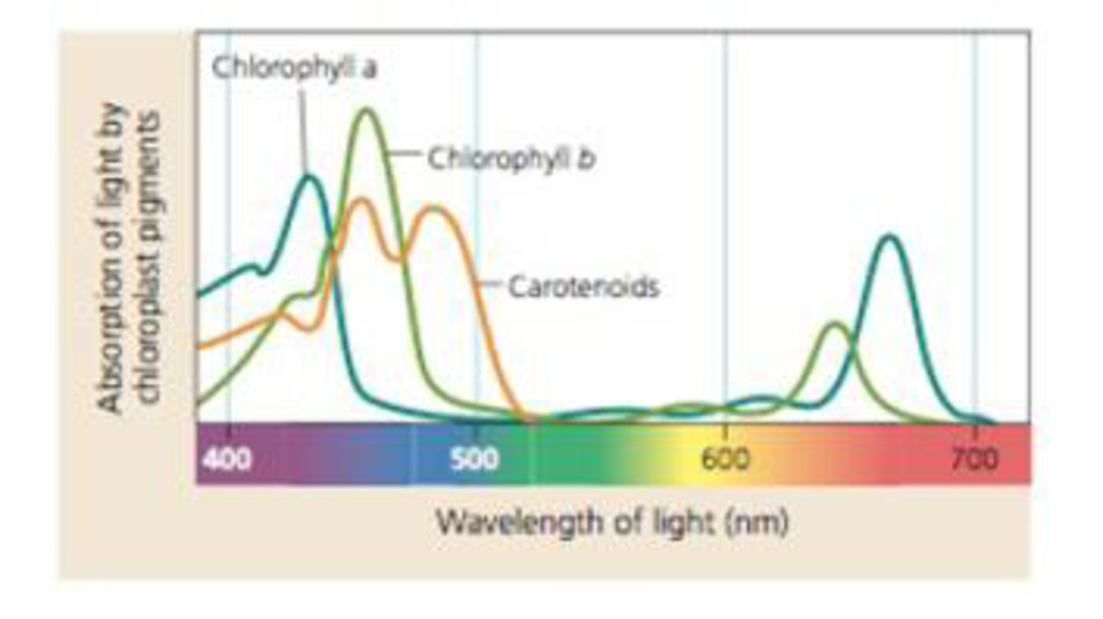
Interpreting Data In the following graph, called an absorption spectrum, each line is made by shining light of varying wavelengths through a sample. For each wavelength, the amount of that light absorbed by the sample is recorded. This graph combines three such measurements, one each for the pigments chlorophyll a, chlorophyll b, and the carotenoids. Notice that the graphs for the chlorophyll pigments match the data presented in Figure 7.5. Imagine a plant that lacks chlorophyll and relies only on carotenoids for photosynthesis. What colors of light would work best for this plant? How would this plant appear to your eye?

Want to see the full answer?
Check out a sample textbook solution
Chapter 7 Solutions
Campbell Essential Biology (7th Edition)
Additional Science Textbook Solutions
Principles of Anatomy and Physiology
Anatomy & Physiology
Brock Biology of Microorganisms (14th Edition)
Biology: Concepts and Investigations
Human Physiology: An Integrated Approach (8th Edition)
- At your work station, you have a spectrophotometer set at 600 nm to measure DCIP absorbance and four (4) test tubes containing different solutions. One of the test tubes is labelled “0” to blank/zero the spectrophotometer. The other three (3) test tubes contain a reaction mixture from a Hill reaction experiment using isolated chloroplasts and DCIP as an electron acceptor. DCIP is present in the oxidized state and exhibits a blue color with an absorbance at 600 nm. Upon receiving the electrons, DCIP is reduced to form DCIP-H2 that is colorless. These three (3) tubes, labelled “A”, “B”, and “C” were exposed to different light conditions during the Hill reaction. The Light conditions were random, including No light, Red light, and Green light. Please note that chlorophyll preferentially absorbs the light with wavelength of 660 nm (red) when compared to that of 520 nm (green). Your mission is to determine which Tube came from which experimental light condition. Tube: Tube…arrow_forwardCyclic photophosphorylation uses two photons to generate one ATP. If the AG of ATP hydrolysis is -50 kj/mol. What is the percent efficiency of cyclic photophosphorylation? F =96.5 kj/mol*V. Use c AG = -nFAV ⒸShow Transcribed Text to solve.arrow_forwardA. The C4 plant performs photosynthesis more efficiently than the C3 when the CO2 concentration is 600ppm or less. Provide one reason why the rate of photosynthesis doesn’t change for the C4 plant when the CO2 concentration increases above 400 ppm. B. Discuss what is happening in the C3 plant when the CO2 levels are below 50 ppm. Provide one reason why this does NOT happen to the C4 plant.arrow_forward
- can you explain what is happening in the attached graph? Figure 2: Lineweaver-Burke plot of ALP Kinetic parameters.arrow_forwardLight that the chlorophyll-a pigment uses may be measured by the solar-induced fluorescence (650-850nm). This fluorescence caused by the sun and a plant's gross primary output are correlated linearly. Why does this reasoning shows that solar induced fluorescence can be used to infer net photosynthesis?arrow_forwardwould you expect an absorption spectrum graph of chlorophyll (green plant pigment involved in photosynthesis) to be the same or not of that for the red food coloring? why?arrow_forward
- Light that the chlorophyll-a pigment uses may be measured by the solar-induced fluorescence (650-850nm). This fluorescence caused by the sun and a plant's gross primary output are correlated linearly. Why can solar induced fluorescence be used to infer net photosynthesis?arrow_forwardThe number of twigs on your tree: 154,000 twigs Based on transpiration measurements that we have made in previous years; each twigtranspires about 3 grams of water per hour on a warm spring day. That is, multiply your tree’s twigs by 3. This is a rough average for all sides of the tree (the south side, exposed to the sun, and the north side, with indirect light.) Calculate the number of grams of water per hour that your tree transpires. ____________g/hr Now convert your grams of water to kilocalories. Remember that the evaporation of a gram of water uses about 0.6 kilocalories of heat, which comes from the air. _____________ kcal/hr Assume that a day is 10 hours long and a month is 30 days. How many kilocalories per month does your tree account for? _________ kcal/mo How many kilowatt hours of electricity would it take to have an air conditioner use this number of kilocalories? One kilowatt hour takes about 860 kilocalories of evaporation. Transpiration in your tree…arrow_forwardSuggest a reason why photosynthetic pigments readily absorb in the blue region of the visible spectrum but do so with low probability in the ultraviolet.arrow_forward
- The graph above illustrates the absorption spectrum of chlorophyll a ONLY. Which colors of the visible light spectrum are absorbed best by chlorophyll a?arrow_forwardThe muscle enzyme lactate dehydrogenase catalyzes the reaction NADH and NAD+ are the reduced and oxidized forms, respectively, of the coenzyme NAD. Solutions of NADH, but not NAD+, absorb light at 340 nm. This property is used to determine the concentration of NADH in solution by measuring spectrophotometrically the amount of light absorbed at 340 nm by the solution. Explain how these properties of NADH can be used to design a quantitative assay for lactate dehydrogenase.arrow_forward(g) The figure given below represents an experiment to demonstrate a particular aspect of photosynthesis. The alphabet 'A' represents a certain condition inside the flask. 2 КОН (i) What is the aim of the experiment ? (ii) Identify the special condition inside the flask. (iii) Name an alternative chemical that can be used instead of KOH. (iv) In what manner do the leaves 1 and 2 differ at the end of the starch test ?arrow_forward
 Human Anatomy & Physiology (11th Edition)BiologyISBN:9780134580999Author:Elaine N. Marieb, Katja N. HoehnPublisher:PEARSON
Human Anatomy & Physiology (11th Edition)BiologyISBN:9780134580999Author:Elaine N. Marieb, Katja N. HoehnPublisher:PEARSON Biology 2eBiologyISBN:9781947172517Author:Matthew Douglas, Jung Choi, Mary Ann ClarkPublisher:OpenStax
Biology 2eBiologyISBN:9781947172517Author:Matthew Douglas, Jung Choi, Mary Ann ClarkPublisher:OpenStax Anatomy & PhysiologyBiologyISBN:9781259398629Author:McKinley, Michael P., O'loughlin, Valerie Dean, Bidle, Theresa StouterPublisher:Mcgraw Hill Education,
Anatomy & PhysiologyBiologyISBN:9781259398629Author:McKinley, Michael P., O'loughlin, Valerie Dean, Bidle, Theresa StouterPublisher:Mcgraw Hill Education, Molecular Biology of the Cell (Sixth Edition)BiologyISBN:9780815344322Author:Bruce Alberts, Alexander D. Johnson, Julian Lewis, David Morgan, Martin Raff, Keith Roberts, Peter WalterPublisher:W. W. Norton & Company
Molecular Biology of the Cell (Sixth Edition)BiologyISBN:9780815344322Author:Bruce Alberts, Alexander D. Johnson, Julian Lewis, David Morgan, Martin Raff, Keith Roberts, Peter WalterPublisher:W. W. Norton & Company Laboratory Manual For Human Anatomy & PhysiologyBiologyISBN:9781260159363Author:Martin, Terry R., Prentice-craver, CynthiaPublisher:McGraw-Hill Publishing Co.
Laboratory Manual For Human Anatomy & PhysiologyBiologyISBN:9781260159363Author:Martin, Terry R., Prentice-craver, CynthiaPublisher:McGraw-Hill Publishing Co. Inquiry Into Life (16th Edition)BiologyISBN:9781260231700Author:Sylvia S. Mader, Michael WindelspechtPublisher:McGraw Hill Education
Inquiry Into Life (16th Edition)BiologyISBN:9781260231700Author:Sylvia S. Mader, Michael WindelspechtPublisher:McGraw Hill Education





